Valerie Chen
Beyond Memorization: Mapping the Originality-Quality Frontier of Language Models
Apr 13, 2025Abstract:As large language models (LLMs) are increasingly used for ideation and scientific discovery, it is important to evaluate their ability to generate novel output. Prior work evaluates novelty as the originality with respect to training data, but original outputs can be low quality. In contrast, non-expert judges may favor high-quality but memorized outputs, limiting the reliability of human preference as a metric. We propose a new novelty metric for LLM generations that balances originality and quality -- the harmonic mean of the fraction of \ngrams unseen during training and a task-specific quality score. We evaluate the novelty of generations from two families of open-data models (OLMo and Pythia) on three creative tasks: story completion, poetry writing, and creative tool use. We find that LLM generated text is less novel than human written text. To elicit more novel outputs, we experiment with various inference-time methods, which reveals a trade-off between originality and quality. While these methods can boost novelty, they do so by increasing originality at the expense of quality. In contrast, increasing model size or applying post-training reliably shifts the Pareto frontier, highlighting that starting with a stronger base model is a more effective way to improve novelty.
The RealHumanEval: Evaluating Large Language Models' Abilities to Support Programmers
Apr 03, 2024



Abstract:Evaluation of large language models (LLMs) for code has primarily relied on static benchmarks, including HumanEval (Chen et al., 2021), which measure the ability of LLMs to generate complete code that passes unit tests. As LLMs are increasingly used as programmer assistants, we study whether gains on existing benchmarks translate to gains in programmer productivity when coding with LLMs, including time spent coding. In addition to static benchmarks, we investigate the utility of preference metrics that might be used as proxies to measure LLM helpfulness, such as code acceptance or copy rates. To do so, we introduce RealHumanEval, a web interface to measure the ability of LLMs to assist programmers, through either autocomplete or chat support. We conducted a user study (N=213) using RealHumanEval in which users interacted with six LLMs of varying base model performance. Despite static benchmarks not incorporating humans-in-the-loop, we find that improvements in benchmark performance lead to increased programmer productivity; however gaps in benchmark versus human performance are not proportional -- a trend that holds across both forms of LLM support. In contrast, we find that programmer preferences do not correlate with their actual performance, motivating the need for better, human-centric proxy signals. We also open-source RealHumanEval to enable human-centric evaluation of new models and the study data to facilitate efforts to improve code models.
Do LLMs exhibit human-like response biases? A case study in survey design
Nov 07, 2023Abstract:As large language models (LLMs) become more capable, there is growing excitement about the possibility of using LLMs as proxies for humans in real-world tasks where subjective labels are desired, such as in surveys and opinion polling. One widely-cited barrier to the adoption of LLMs is their sensitivity to prompt wording -- but interestingly, humans also display sensitivities to instruction changes in the form of response biases. As such, we argue that if LLMs are going to be used to approximate human opinions, it is necessary to investigate the extent to which LLMs also reflect human response biases, if at all. In this work, we use survey design as a case study, where human response biases caused by permutations in wordings of ``prompts'' have been extensively studied. Drawing from prior work in social psychology, we design a dataset and propose a framework to evaluate whether LLMs exhibit human-like response biases in survey questionnaires. Our comprehensive evaluation of nine models shows that popular open and commercial LLMs generally fail to reflect human-like behavior. These inconsistencies tend to be more prominent in models that have been instruction fine-tuned. Furthermore, even if a model shows a significant change in the same direction as humans, we find that perturbations that are not meant to elicit significant changes in humans may also result in a similar change, suggesting that such a result could be partially due to other spurious correlations. These results highlight the potential pitfalls of using LLMs to substitute humans in parts of the annotation pipeline, and further underscore the importance of finer-grained characterizations of model behavior. Our code, dataset, and collected samples are available at https://github.com/lindiatjuatja/BiasMonkey
AdvisingNets: Learning to Distinguish Correct and Wrong Classifications via Nearest-Neighbor Explanations
Aug 25, 2023Abstract:Besides providing insights into how an image classifier makes its predictions, nearest-neighbor examples also help humans make more accurate decisions. Yet, leveraging this type of explanation to improve both human-AI team accuracy and classifier's accuracy remains an open question. In this paper, we aim to increase both types of accuracy by (1) comparing the input image with post-hoc, nearest-neighbor explanations using a novel network (AdvisingNet), and (2) employing a new reranking algorithm. Over different baseline models, our method consistently improves the image classification accuracy on CUB-200 and Cars-196 datasets. Interestingly, we also reach the state-of-the-art human-AI team accuracy on CUB-200 where both humans and an AdvisingNet make decisions on complementary subsets of images.
FeedbackLogs: Recording and Incorporating Stakeholder Feedback into Machine Learning Pipelines
Jul 28, 2023



Abstract:Even though machine learning (ML) pipelines affect an increasing array of stakeholders, there is little work on how input from stakeholders is recorded and incorporated. We propose FeedbackLogs, addenda to existing documentation of ML pipelines, to track the input of multiple stakeholders. Each log records important details about the feedback collection process, the feedback itself, and how the feedback is used to update the ML pipeline. In this paper, we introduce and formalise a process for collecting a FeedbackLog. We also provide concrete use cases where FeedbackLogs can be employed as evidence for algorithmic auditing and as a tool to record updates based on stakeholder feedback.
Learning Personalized Decision Support Policies
Apr 13, 2023Abstract:Individual human decision-makers may benefit from different forms of support to improve decision outcomes. However, a key question is which form of support will lead to accurate decisions at a low cost. In this work, we propose learning a decision support policy that, for a given input, chooses which form of support, if any, to provide. We consider decision-makers for whom we have no prior information and formalize learning their respective policies as a multi-objective optimization problem that trades off accuracy and cost. Using techniques from stochastic contextual bandits, we propose $\texttt{THREAD}$, an online algorithm to personalize a decision support policy for each decision-maker, and devise a hyper-parameter tuning strategy to identify a cost-performance trade-off using simulated human behavior. We provide computational experiments to demonstrate the benefits of $\texttt{THREAD}$ compared to offline baselines. We then introduce $\texttt{Modiste}$, an interactive tool that provides $\texttt{THREAD}$ with an interface. We conduct human subject experiments to show how $\texttt{Modiste}$ learns policies personalized to each decision-maker and discuss the nuances of learning decision support policies online for real users.
Assisting Human Decisions in Document Matching
Feb 16, 2023
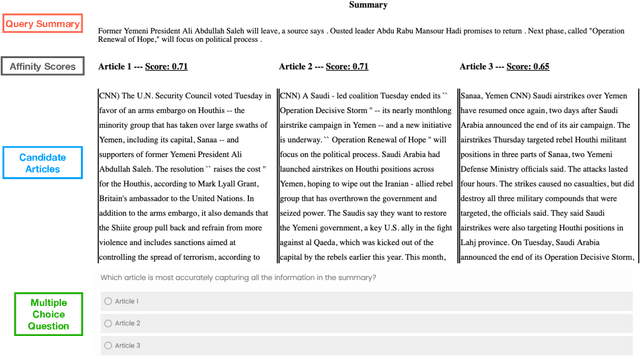
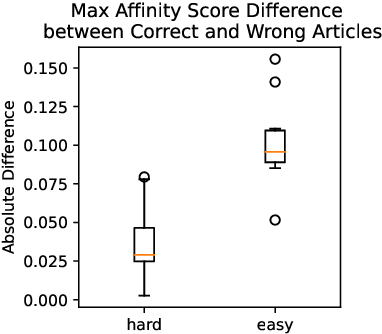

Abstract:Many practical applications, ranging from paper-reviewer assignment in peer review to job-applicant matching for hiring, require human decision makers to identify relevant matches by combining their expertise with predictions from machine learning models. In many such model-assisted document matching tasks, the decision makers have stressed the need for assistive information about the model outputs (or the data) to facilitate their decisions. In this paper, we devise a proxy matching task that allows us to evaluate which kinds of assistive information improve decision makers' performance (in terms of accuracy and time). Through a crowdsourced (N=271 participants) study, we find that providing black-box model explanations reduces users' accuracy on the matching task, contrary to the commonly-held belief that they can be helpful by allowing better understanding of the model. On the other hand, custom methods that are designed to closely attend to some task-specific desiderata are found to be effective in improving user performance. Surprisingly, we also find that the users' perceived utility of assistive information is misaligned with their objective utility (measured through their task performance).
A Case Study on Designing Evaluations of ML Explanations with Simulated User Studies
Feb 15, 2023Abstract:When conducting user studies to ascertain the usefulness of model explanations in aiding human decision-making, it is important to use real-world use cases, data, and users. However, this process can be resource-intensive, allowing only a limited number of explanation methods to be evaluated. Simulated user evaluations (SimEvals), which use machine learning models as a proxy for human users, have been proposed as an intermediate step to select promising explanation methods. In this work, we conduct the first SimEvals on a real-world use case to evaluate whether explanations can better support ML-assisted decision-making in e-commerce fraud detection. We study whether SimEvals can corroborate findings from a user study conducted in this fraud detection context. In particular, we find that SimEvals suggest that all considered explainers are equally performant, and none beat a baseline without explanations -- this matches the conclusions of the original user study. Such correspondences between our results and the original user study provide initial evidence in favor of using SimEvals before running user studies. We also explore the use of SimEvals as a cheap proxy to explore an alternative user study set-up. We hope that this work motivates further study of when and how SimEvals should be used to aid in the design of real-world evaluations.
Understanding the Role of Human Intuition on Reliance in Human-AI Decision-Making with Explanations
Jan 18, 2023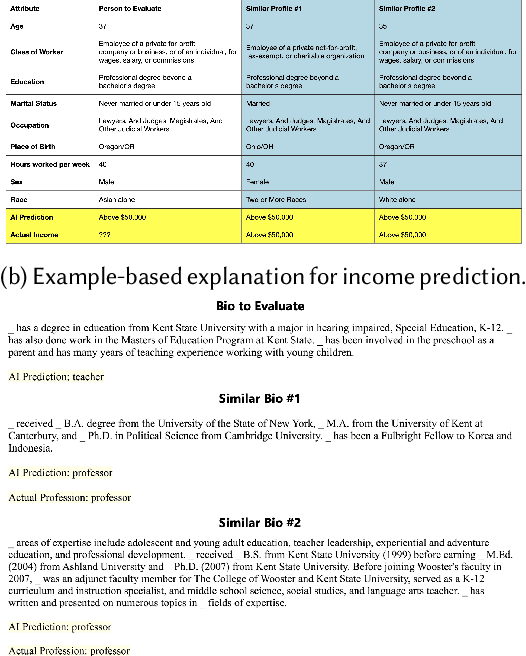
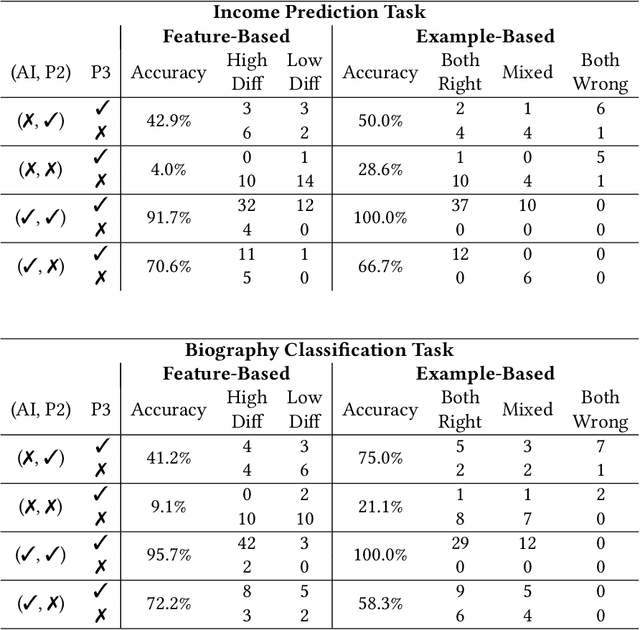
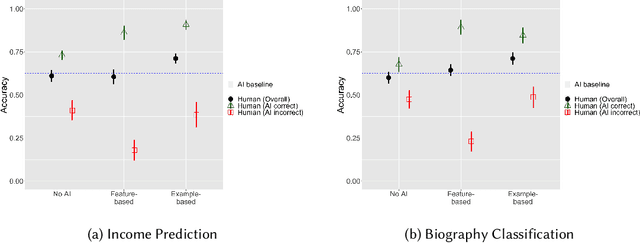
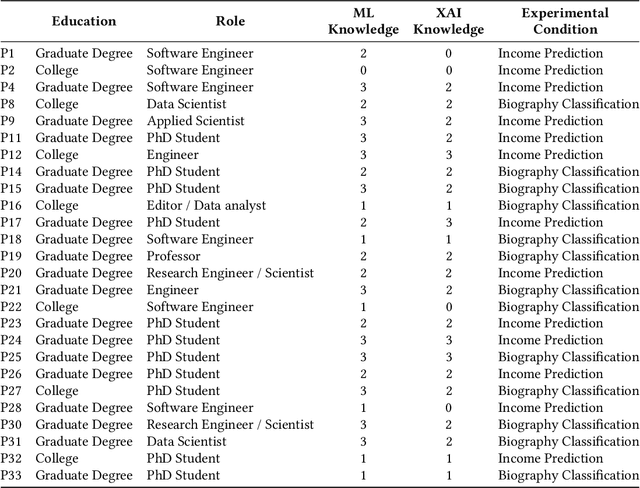
Abstract:AI explanations are often mentioned as a way to improve human-AI decision-making. Yet, empirical studies have not found consistent evidence of explanations' effectiveness and, on the contrary, suggest that they can increase overreliance when the AI system is wrong. While many factors may affect reliance on AI support, one important factor is how decision-makers reconcile their own intuition -- which may be based on domain knowledge, prior task experience, or pattern recognition -- with the information provided by the AI system to determine when to override AI predictions. We conduct a think-aloud, mixed-methods study with two explanation types (feature- and example-based) for two prediction tasks to explore how decision-makers' intuition affects their use of AI predictions and explanations, and ultimately their choice of when to rely on AI. Our results identify three types of intuition involved in reasoning about AI predictions and explanations: intuition about the task outcome, features, and AI limitations. Building on these, we summarize three observed pathways for decision-makers to apply their own intuition and override AI predictions. We use these pathways to explain why (1) the feature-based explanations we used did not improve participants' decision outcomes and increased their overreliance on AI, and (2) the example-based explanations we used improved decision-makers' performance over feature-based explanations and helped achieve complementary human-AI performance. Overall, our work identifies directions for further development of AI decision-support systems and explanation methods that help decision-makers effectively apply their intuition to achieve appropriate reliance on AI.
On the Importance of Application-Grounded Experimental Design for Evaluating Explainable ML Methods
Jun 30, 2022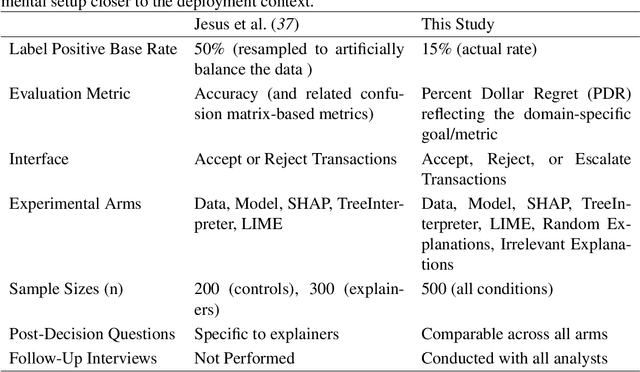


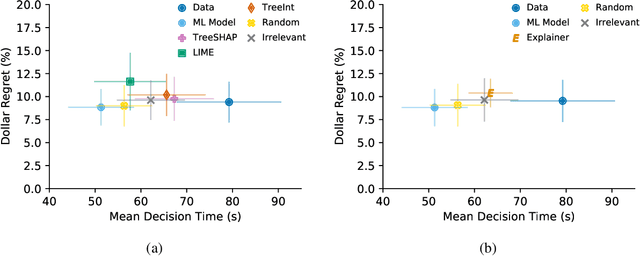
Abstract:Machine Learning (ML) models now inform a wide range of human decisions, but using ``black box'' models carries risks such as relying on spurious correlations or errant data. To address this, researchers have proposed methods for supplementing models with explanations of their predictions. However, robust evaluations of these methods' usefulness in real-world contexts have remained elusive, with experiments tending to rely on simplified settings or proxy tasks. We present an experimental study extending a prior explainable ML evaluation experiment and bringing the setup closer to the deployment setting by relaxing its simplifying assumptions. Our empirical study draws dramatically different conclusions than the prior work, highlighting how seemingly trivial experimental design choices can yield misleading results. Beyond the present experiment, we believe this work holds lessons about the necessity of situating the evaluation of any ML method and choosing appropriate tasks, data, users, and metrics to match the intended deployment contexts.
 Add to Chrome
Add to Chrome Add to Firefox
Add to Firefox Add to Edge
Add to Edge